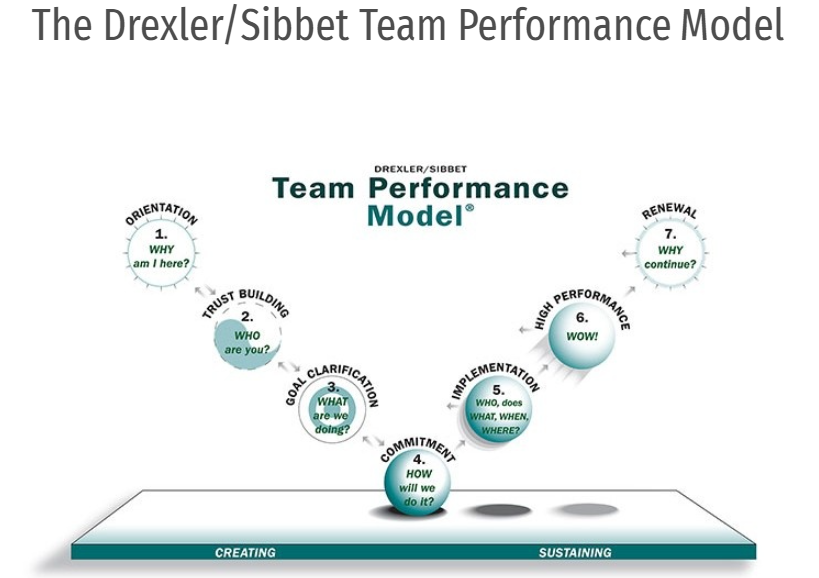Drexler/Sibbet Model for Team development and project management
Contents |
Abstract
Team development is the process through which a group is formed in order to achieve the goal of giving life to a successful project. Despite the skills of every member of the team, it is of great importance for it to reach high standards of teamwork and collaboration. There are different approaches and methods that can be implemented in forming a team and make it develop and work in a positive way. [1]
Allan Drexler and David Sibbet suggested a team performance model with seven steps. Steps 1 to 4, describe the number of stages that need to take place in creating a project team. Through steps 5 to 7, they analyze project team sustainability and performance. [3]
Model Description
Step 1: Orientation.
Why is this team formed?
First and foremost, it is of vital importance for the scope of the project to be clarified during the first meeting of the new team. Everybody needs to have in mind the reason behind forming the team and the final goal to which the team is heading to.
Step 2: Trust building.
Who?
Through this stage, every team member finds out his/her colleagues, their skills and specific roles that they are going to serve during the project.
Step 3: Goal clarification.
What?
This is when the analysis is taking place. The team is expected to take into account every available information regarding the project.The stakeholders of the project are analysed, since their influence may play a significant role while doing the project. The dates for the assignments are clarified, in addition to all the criteria that need to be specified before the kick-off of the project.
Step 4: Commitment.
How?
In this stage the team is starting to plan the way it is going to operate moving forward, so as to achieve the final goal. After a -as detailed as possible- planning, the team needs to come up with a total budget, needed for the project to be carried out.
Step 5: Implementation.
The team is starting to work towards bringing the deliverables and meeting the specific timelines of the plan.
Step 6: High performance.
The members of the team have managed to perform in a way that is very sufficient. This, though, is something that does not happen in every team. There are a lot of teams that have managed to do successful projects without working in such high levels. However, in this model everything is analysed in a way that there is serious likelihood for a team to perform in a high level.
Step 7: Renewal.
In this stage, the team examines the performance of every team member and the methods that were followed and proposes changes that can lead to even more sufficient group work.
Practical Approach
Formulating a team is a process that takes energy, time and needs everybody involved into finding common grounds. [4] This model is a step to optimizing the workflow of a team.
Reflections & Conclusion
References
- ↑ [Image of the Drexler/Sibbet Model] https://www.thegrove.com/methodology/team-performance-model
- ↑ [Image of the Drexler/Sibbet Model] https://www.thegrove.com/methodology/team-performance-model
- ↑ [A Guide to the Project Management Body of Knowledge (PMBOK ® Guide) – 7th Edition and The Standard for Project Management - 4.2.6.2 Drexler/Sibbet Team Performance Model. (pp. 14). Project Management Institute, Inc. (PMI)] https://app.knovel.com/hotlink/pdf/id:kt012LZKY8/guide-project-management/drexler-sibbet-team-performance
- ↑ [Using the Drexler/Sibbet Model] https://www.youtube.com/watch?v=2d2JPIl_oBw&ab_channel=HartfordFoundation
